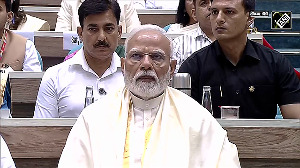The gigantic size of Mulayam Singh Yadav's current ministry in Uttar Pradesh has inevitably drawn comparisons with the past when a government's priority was providing stability rather than merely surviving at all costs.
Those were the days when Prime Minister Jawaharlal Nehru's writ ran large all over the country and in the Congress party. He ensured that Congress ministries in the states, especially Uttar Pradesh, did not outgrow their utility in stark contrast to what is happening now.
When Govind Ballabh Pant constituted Uttar Pradesh's first ministry on May 20, 1952, his council of ministers were a tight 25 members.
Pant was a close associate of Nehru, a well-known participant in the freedom struggle, and was easily the first choice to head Uttar Pradesh. His tenure lasted till December 27, 1954 when Nehru made him Union home minister.
Dr Sampoornanand, a scholar of Sanskrit and Hindi, succeeded Pant. His council of ministers numbered 28 and the educationist ruled UP till April 9, 1957. He later became governor of Rajasthan.
Sucheta Kripalani became India's first woman chief minister on October 2, 1963. Her ministry too had 28 ministers. The 62-day state employees agitation in Uttar Pradesh saw her government dislodged on March 13, 1967. It was replaced by the C B Gupta government, which lasted just 18 days.
Charan Singh then defected from the Congress with 18 members and formed the Jana Congress, which was sworn in on April 3, 1967. His government, with 31 ministers, lasted till February 25, 1968.
Hemvati Nandan Bahuguna was sworn in chief minister on the Ides of March 1974, with just 21 members in his council of ministers. He ruled till November 29, 1975.
Narain Dutt Tewari (now chief minister of Uttaranchal) became chief minister on January 21, 1976. His government with 31 ministers came to an end on April 30, 1977, after Indira Gandhi decided to lift the Emergency and hold elections.
It was the rise of the 'dal badloo' (defector) phenomenon, which has taken deep root in the Indian polity over the last three decades that necessitated the need to keep politicians happy by making them ministers for fear that if not so appointed, the politician would defect.
The phenomena of jumbo-sized ministries in Uttar Pradesh became entrenched with the Bharatiya Janata Party's Chief Minister Kalyan Singh. His government, which lasted from October 21, 1997 to November 12, 1999, had 93 ministers. Forced to keep all his coalition partners and those who had defected to join him and give him a much needed majority happy, Singh appointed as ministers all those who helped him cobble up his lead in the legislature.
When Ram Prakash Gupta replaced Kalyan Singh, he maintained the trend and had 91 members in his council of ministers. Gupta's government ruled from November 12, 1999 to March 28, 2000. Health problems saw him replaced by Rajnath Singh.
The Thakur leader, now Union rural development minister, continued the trend of jumbo-sized ministries; his government, sworn in on October 28, 2000 had 86 ministers. It lasted till March 8, 2002.
Bahujan Samaj Party Chief Minister Mayawati's second stint began on May 3, 2002 when she formed her government with the BJP's help. Her ministry had 87 ministers.
She was succeeded by Mulayam Singh Yadav, who, in a desperate bid to ensure that there is no threat to his government, may cross the 100 ministers mark soon.






 © 2025
© 2025